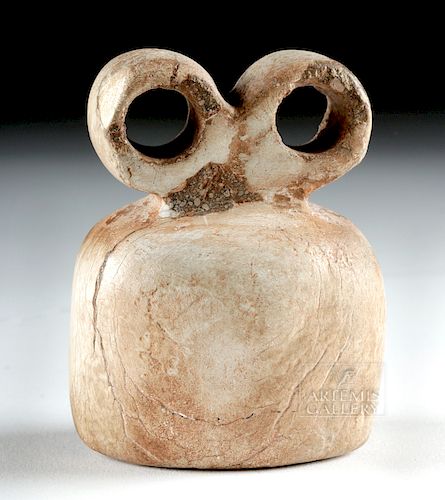Tell Brak Stone Eye Idol
Lot 79b
About Seller
Artemis Fine Arts
686 S Taylor Ave, Ste 106
Louisville, CO 80027
United States
Selling antiquities, ancient and ethnographic art online since 1993, Artemis Gallery specializes in Classical Antiquities (Egyptian, Greek, Roman, Near Eastern), Asian, Pre-Columbian, African / Tribal / Oceanographic art. Our extensive inventory includes pottery, stone, metal, wood, glass and textil...Read more
Estimate:
$1,500 - $2,000
Absentee vs Live bid
Two ways to bid:
- Leave a max absentee bid and the platform will bid on your behalf up to your maximum bid during the live auction.
- Bid live during the auction and your bids will be submitted real-time to the auctioneer.
Bid Increments
| Price | Bid Increment |
|---|---|
| $0 | $25 |
| $300 | $50 |
| $1,000 | $100 |
| $2,000 | $250 |
| $5,000 | $500 |
| $10,000 | $1,000 |
| $20,000 | $2,500 |
| $50,000 | $5,000 |
| $100,000 | $10,000 |
| $200,000 | $20,000 |
About Auction
By Artemis Fine Arts
Feb 6, 2019
Set Reminder
2019-02-06 10:00:00
2019-02-06 10:00:00
America/New_York
Bidsquare
Bidsquare : Ancient | Ethnographic | Fine Art
https://www.bidsquare.com/auctions/artemis-gallery/ancient-ethnographic-fine-art-3848
Featuring classical antiquities, ancient and ethnographic art from cultures encompassing the globe. Artemis Fine Arts info@artemisgallery.com
Featuring classical antiquities, ancient and ethnographic art from cultures encompassing the globe. Artemis Fine Arts info@artemisgallery.com
- Lot Description
Ancient Near East, modern Syria, Tell Brak, Late Uruk Period, ca. 3300 to 3000 BCE. A fine and abstract eye idol, hand-carved from creamy white stone with areas of brown and salmon-pink coloration. One of the most famous types of early Mesopotamia, it has a bell-shaped body surmounted by two conjoined circles with drilled loops which form the "eyes." Eye idols were named in the 1930s by the British archaeologist Max Mallowan when he was excavating at the mound called Tell Brak and found hundreds of small anthropomorphic items of similar form to this one - some kind of simplified body topped by huge discs for eyes and no other discernible facial features. He named the place where he found them "The Temple of the Eyes." Size: 2.125" W x 2.8" H (5.4 cm x 7.1 cm).
More recently, items like this one have been found beyond the Temple of the Eyes, leading French archaeologist Catherine Breniquet to speculate that examples like this one could have also been used for separating wool while spinning. The object would have been placed in front of a seated person who used the holes to separate two or three strands and then twist them together. Artwork on cylinder seals from Uruk seems to support this hypothesis. Other scholars have suggested they might have been lids for narrow jars or parts of a firedog. What do you think this mysterious object might have been?
Provenance: private East Coast, USA collection; ex-Richard Wagner collection, Cape Cod, Massachusetts, USA, acquired in the 1960s
All items legal to buy/sell under U.S. Statute covering cultural patrimony Code 2600, CHAPTER 14, and are guaranteed to be as described or your money back.
A Certificate of Authenticity will accompany all winning bids.
We ship worldwide and handle all shipping in-house for your convenience.
#143623Several small areas of repair to eyes with minor chips and light adhesive residue along break lines as well as some earthen stabilization material. Minor nicks and abrasions to base, body, and eyes, with a few stable fissures. Light earthen deposits and patina throughout.Condition
- Shipping Info
-
All shipping is handled in-house for your convenience. Your invoice from Artemis Gallery will include shipping calculation instructions. If in doubt, please inquire BEFORE bidding for estimated shipping costs for individual items.
-
- Buyer's Premium



 EUR
EUR CAD
CAD AUD
AUD GBP
GBP MXN
MXN HKD
HKD CNY
CNY MYR
MYR SEK
SEK SGD
SGD CHF
CHF THB
THB
















